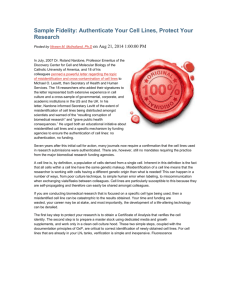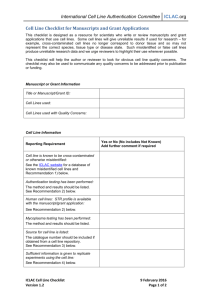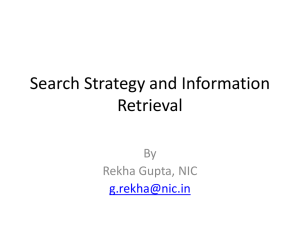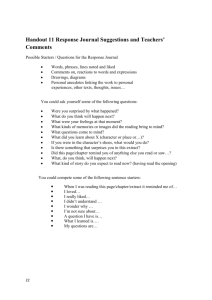Pollution of Biomedical Journals - Cell Line Authentication Global
advertisement
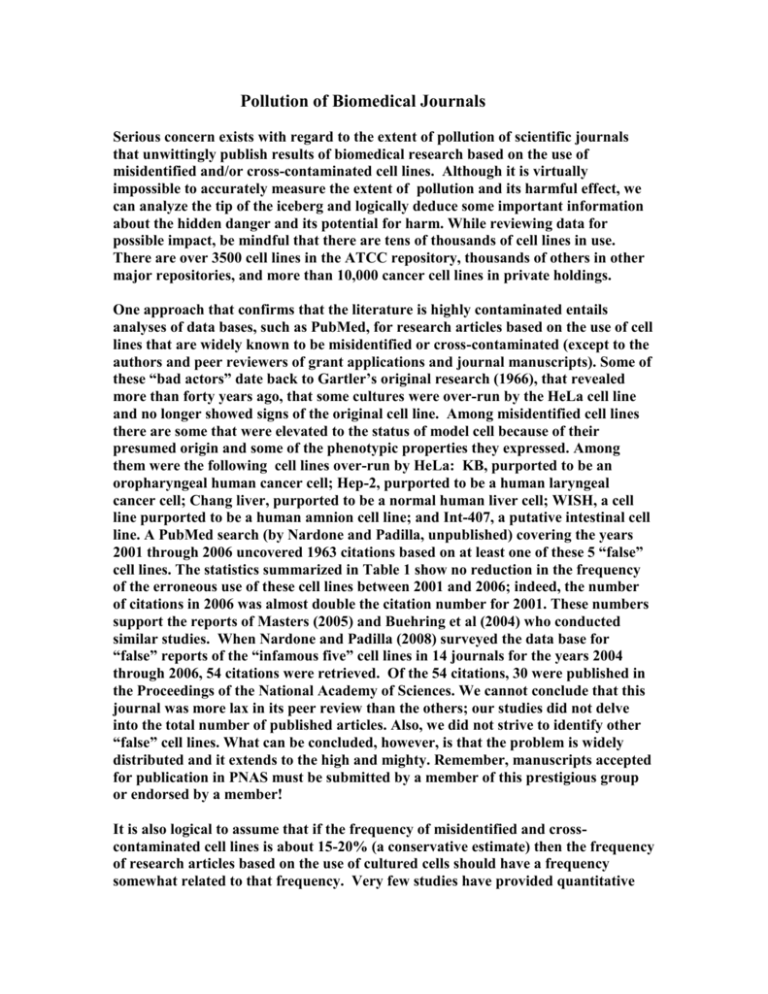
Pollution of Biomedical Journals Serious concern exists with regard to the extent of pollution of scientific journals that unwittingly publish results of biomedical research based on the use of misidentified and/or cross-contaminated cell lines. Although it is virtually impossible to accurately measure the extent of pollution and its harmful effect, we can analyze the tip of the iceberg and logically deduce some important information about the hidden danger and its potential for harm. While reviewing data for possible impact, be mindful that there are tens of thousands of cell lines in use. There are over 3500 cell lines in the ATCC repository, thousands of others in other major repositories, and more than 10,000 cancer cell lines in private holdings. One approach that confirms that the literature is highly contaminated entails analyses of data bases, such as PubMed, for research articles based on the use of cell lines that are widely known to be misidentified or cross-contaminated (except to the authors and peer reviewers of grant applications and journal manuscripts). Some of these “bad actors” date back to Gartler’s original research (1966), that revealed more than forty years ago, that some cultures were over-run by the HeLa cell line and no longer showed signs of the original cell line. Among misidentified cell lines there are some that were elevated to the status of model cell because of their presumed origin and some of the phenotypic properties they expressed. Among them were the following cell lines over-run by HeLa: KB, purported to be an oropharyngeal human cancer cell; Hep-2, purported to be a human laryngeal cancer cell; Chang liver, purported to be a normal human liver cell; WISH, a cell line purported to be a human amnion cell line; and Int-407, a putative intestinal cell line. A PubMed search (by Nardone and Padilla, unpublished) covering the years 2001 through 2006 uncovered 1963 citations based on at least one of these 5 “false” cell lines. The statistics summarized in Table 1 show no reduction in the frequency of the erroneous use of these cell lines between 2001 and 2006; indeed, the number of citations in 2006 was almost double the citation number for 2001. These numbers support the reports of Masters (2005) and Buehring et al (2004) who conducted similar studies. When Nardone and Padilla (2008) surveyed the data base for “false” reports of the “infamous five” cell lines in 14 journals for the years 2004 through 2006, 54 citations were retrieved. Of the 54 citations, 30 were published in the Proceedings of the National Academy of Sciences. We cannot conclude that this journal was more lax in its peer review than the others; our studies did not delve into the total number of published articles. Also, we did not strive to identify other “false” cell lines. What can be concluded, however, is that the problem is widely distributed and it extends to the high and mighty. Remember, manuscripts accepted for publication in PNAS must be submitted by a member of this prestigious group or endorsed by a member! It is also logical to assume that if the frequency of misidentified and crosscontaminated cell lines is about 15-20% (a conservative estimate) then the frequency of research articles based on the use of cultured cells should have a frequency somewhat related to that frequency. Very few studies have provided quantitative information. The German cell culture repository (DSMZ) has examined hundreds of submitted cell lines and its staff has reported the following. In 1999, MacLeod et al reported that 18% of the new cell lines submitted were false and 29% of the originators depositing cell lines had submitted at least one false culture. Another survey dealing with hematopoietic cell lines found that 45 of 326 submissions (17.9%) were cross-contaminated (Drexler et al, 1999). Masters et al (2001) reported the outcome of a cooperative DNA profiling study by the ATCC, the DMSZ, and JCRB (the Japanese Cell Research Bank). Thirty-six percent cross-contamination was found. It is apparent that the owners and editors of journals that publish outcomes of cell culture- based research, must undertake special action in order to reduce the publication of misleading and wasteful articles. This can be achieved by announcing that papers which present no evidence of cell line authentication and characterization will not be accepted. It also requires that peer reviewers be properly informed of existing criteria that should be met by the author and enforced by the reviewer. We hope that the cell authentication initiative I have undertaken will lead to a profession-wide consensus with journals and funding agencies adopting a zero tolerance policy: no cell line authentication/no publication; no cell line authentication/no grant. Such a policy would not be an unusually difficult burden for scientists to carry. More importantly, it would ensure uniform compliance and protect the underpinnings of good scientific research (Nardone, 2007). Literature Cited Buehring, G., Eby, A., and Eby, M. 2004. Cell line cross-contamination: How aware are mammalian cell culturists of the problem and how to monitor it. In Vitro Cell Dev. Biol. Animal 40: 211-215. Drexler, H., Dirks, W., and MacLeod,R. 1999. False human hematopoietic cell lines;cross-contamionations and misrepresentations. Leukemia 13:1601-16067. Gartler, S. 1966. Genetic markers as tracers in cell culture. Nat. Cancer Inst. Mono. 265:167-195. MacLeod, R., Dirks, W., Matsuo, Y., Kaufman, M., Milch, H., and Drexler, H. Widespread intraspecies cross-contamination of human tumor cell lines arising at source. Int. J. Cancer 83:555-563. Masters, J., Thomson,J., Daly-Burns B., Reid, Y., Dirks, W., Packer, P., Toji, L., Ohno, T., Tanabe, H., Arlett, C., Kelland, L., Harrison, M., Vermani, A., Ward, T., Ayres, K., and Debenham, P. 2001. Short tandem repeat profiling provides an international reference standard for human cell lines. Proc. Natl. Acad. Sci. 98: 8012-8017. Masters, J. 2005. Report presented at the Annual Meeting of the Society for in Vitro Biology. Nardone, R. M. 2007. Eradication of cross-contaminated cell lines: A call for action. Cell Biol. and Toxicol., May 24, 2007. Epub ahead of print PMID 17522957. Nardone, R. and Padilla, V. 2008. A PubMed search for misidentified cell lines, 2001-2006: Five cell lines and fourteen journals. Personal communication. Roland M. Nardone nardone@cua.edu http://cellid.cua.edu Table 1. Use of 12 False Cell Lines*: A PubMed Search, 2001-2006. Year Number of Articles 2001 2002 2003 2004 2005 2006 203 297 323 376 386 378 *Esophageal carcinoma ,squamous carcinoma, TE-7, TE-2, TE-3, TE-12, TE-13, Chang liver, Int-407, WISH, Hep-2, KB. Table 2. Use of Five False “Model” Cell Lines: A PubMed Search, 2001-2006. Year Chang Liver Int-407 WISH Hep-2 KB 2001 2002 2003 2004 2005 2006 7 8 10 12 8 18 8 6 10 8 9 9 9 14 6 10 8 9 35 65 99 111 89 101 74 114 99 122 118 109
